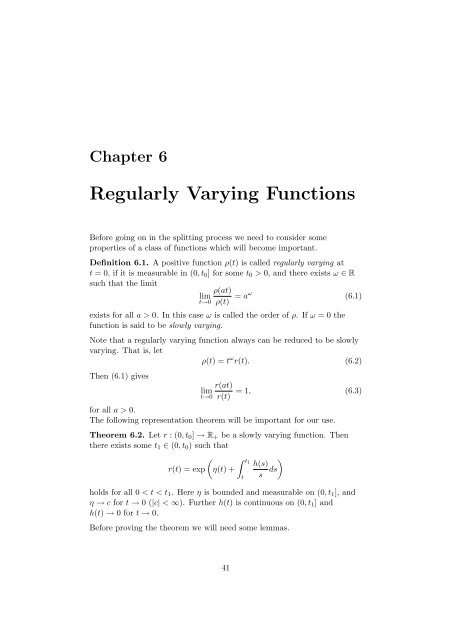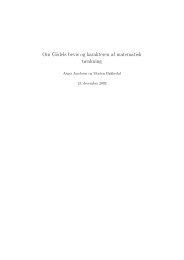Master Dissertation
Master Dissertation
Master Dissertation
You also want an ePaper? Increase the reach of your titles
YUMPU automatically turns print PDFs into web optimized ePapers that Google loves.
Chapter 6<br />
Regularly Varying Functions<br />
Before going on in the splitting process we need to consider some<br />
properties of a class of functions which will become important.<br />
Definition 6.1. A positive function ρ(t) is called regularly varying at<br />
t = 0, if it is measurable in (0, t0] for some t0 > 0, and there exists ω ∈ R<br />
such that the limit<br />
ρ(at)<br />
lim = aω<br />
t→0 ρ(t)<br />
exists for all a > 0. In this case ω is called the order of ρ. If ω = 0 the<br />
function is said to be slowly varying.<br />
(6.1)<br />
Note that a regularly varying function always can be reduced to be slowly<br />
varying. That is, let<br />
ρ(t) = t ω r(t). (6.2)<br />
Then (6.1) gives<br />
r(at)<br />
lim = 1, (6.3)<br />
t→0 r(t)<br />
for all a > 0.<br />
The following representation theorem will be important for our use.<br />
Theorem 6.2. Let r : (0, t0] → R+ be a slowly varying function. Then<br />
there exists some t1 ∈ (0, t0) such that<br />
t1 h(s)<br />
r(t) = exp η(t) +<br />
t s ds<br />
<br />
holds for all 0 < t < t1. Here η is bounded and measurable on (0, t1], and<br />
η → c for t → 0 (|c| < ∞). Further h(t) is continuous on (0, t1] and<br />
h(t) → 0 for t → 0.<br />
Before proving the theorem we will need some lemmas.<br />
41



